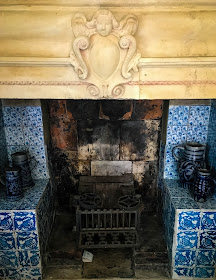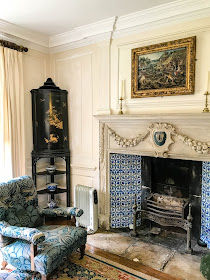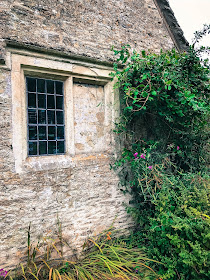 |
| Kelmscott Manor |
William Morris once wrote, 'Have nothing in your house that you do know know to be useful or believe to beautiful'. If one thinks of one's house as one's life, then I believe this is a statement by which to live. When I wrote copy for a real estate company, I tried to use the maxim in the marketing, but the editor scrapped it saying, 'that's too high-brow for our readership'. Sigh.
It should have come as no surprise then, that William Morris's Cotswold retreat at Kelmscott Manor was perfect. Everything is just so and nothing seems out of place or contrived. It is the equivalent of those people who spend hours on their look to give the impression that they have just got out of bed, and yet are designed to within an inch of their life. And I loved it.
 |
| Blue Silk Dress - Dante Gabriel Rossetti |
 |
| Jane Burden - Dante Gabrielle Rossetti |
The Manor is open from April to October on Wednesdays and Saturdays - one might say it was incredibly fortuitous that these opening times coincided with our Thames Path Walk schedule (which was exceptionally tight). Or, one might say that there were two things I planned around which to fit the walk - this being one of them.
The staff are all volunteers and they are helpful and knowledgeable; welcoming and friendly - I couldn't recommend them highly enough. When we first arrived with our rucksacks, we were apologetically informed that we would have to leave them at the entrance, and I think we quite startled the lovely lady on reception with our great sighs of relief!
The house is furnished with an outstanding collection of the possessions and works of Morris as well as of his family and associates (Benson, Burne-Jones, Rossetti and Webb among them) that includes furniture, original textiles, pictures and paintings, carpets, ceramics and metalwork.
Penelope was designed as one of a series of wall hangings depicting heroines from literature and myth, adapted from one of Morris's favourite books - Chaucer's Legends of Good Women - written in the 1380s. It was designed by William Morris for the drawing room at Red House and worked by Bessie Burden (Jane Morris's sister).
Guinevere is another of the Red House wall hangings. This one, for which Jane Morris was the model, was never completed. Neither was the room's ambitious decorative scheme ever completed but eight of the panels survive - three of them at Kelmscott Manor.
 |
| Designs for the Signs of the Zodiac by Edward Burne Jones (1865) |
Morris, Marshall, Faulkner & Co.'s second major commission was for the Green Dining Room at South Kensington Museum, now the Victoria and Albert Museum. Philip Webb designed the overall scheme with the decorative plasterwork and wooden panelling; the Zodiac designs were for the small painted and gilded wall panels.
Even William Morris' overcoat is superb in its simplicity and detail. Unfortunately, I spent the rest of the day humming 'in my William Morris overcoat' to the 'tune' of Joy Division Oven Gloves
All the rooms are exquisite, with everything immaculately spaced and curated to give a sense of calm and satisfaction when walking around the house. Every object draws you to it, inviting you to touch it, pick it up, sit on it... you can't: one woman did and she was severely reprimanded in the most Society of Antiquaries of London manner - she was asked to 'please don't touch, madam'.
"Everywhere there was but little furniture, and that only the most necessary, and of the simplest forms. The extravagant love of ornament which I had noted in this people elsewhere seemed here to have given place to the feeling that the house itself and its associations was the ornament of the country life amidst which it had been left stranded from old times, and that to re-ornament it would but take away its use as a piece of natural beauty." - William Morris, News from NowherePossibly the only thing that looks as though it is 'displayed' is deliberate. In the closet the shelves were designed specifically (by Philip Webb) to house the Morris's superb collection of blue and white patterned china.
The bed moved Morris to poetry and he composed Inscription for an Old Bed, the words of which surround the pelmet. The bedcover with its elegant and intricate depictions of plants of flowers was designed by May and embroidered by Jane. It's clearly a magnificent and inspirational piece of furniture.
Jane's bedroom also manages to be both a comfortable space and a thing of great beauty. The bed is, once again, utterly magnificent featuring the Homestead and the Forest cot quilt designed by May Morris and embroidered by her mother, Jane. It depicts a child-like representation of the Manor surrounded by the Thames and amidst a delightful miscellany of wild and domestic animals, birds and fishes - including foxes, a giraffe, elephant, tiger, crocodile and bear. Of course the lions are my favourite - those paws!
The borders of the piece are decorated with proverbs and quotations, which show how closely May was aligned with the socialist ideals of her father. Everyone should have a quilt like this. It has only recently been returned to Kelmscott Manor after having been held in private hands for 70 years. It's wonderful that it is back where it belongs.
 |
| Homestead and the Forest |
Naturally, even the towels and fire screens are elaborately embroidered, but nothing feels excessive and is all done with impeccable good taste. The late seventeenth-century inlaid marquetry chest is intricate and eye-catching, but while the small jewel case is equally well-crafted, it leaves me cold. This is probably because, while it belonged to Jane, it was decorated by Rossetti and his wife, Elizabeth (aka Lizzie Siddal). The central panel depicts lovers, which is not exactly subtle as Rossetti was conducting an affair with Jane at this time under the nose (and roof) of her husband and his wife.
The Tapestry Room was used by Rossetti as a studio. When he left Kelmscott, William and May both used it as a working space. It is lined with tapestries which were in situ when Morris found the house. Depicting the life and death of Samson, many of them are wickedly violent but the naivete of style, rich decorative detail and faded colours make them attractive and fascinating. Rossetti didn't like these images, finding them creepy and disturbing - Morris did like them, however, so they stayed.
The late seventeenth-century Portuguese desk has small drawers inlaid with paler olive wood and ivory. The fireplace has blue and yellow or grey patterned tiles. But the focal point of the room is the long oak table specifically designed by Philip Webb. It is currently used to display a facsimile of The Works of Geoffrey Chaucer designed and printed by The Kelmscott Press.
The Kelmscott Press was one of Morris's attempts to preserve the old relationships between the artist and his art and his society. In 1891 he rented a cottage near Kelmscott House and set up three printing presses, intent on printing and binding fine books, influenced by Mediaeval illuminated manuscripts and the work of early printers such as Caxton. The books issued by the Kelmscott Press were expensive - Morris designed his own typefaces, made his own paper, and printed by hand - but they were beautiful. They were designed to be read slowly; to be appreciated; to be treasured.
The Works of Geoffrey Chaucer is considered to be the finest achievement of the Kelmscott Press. Designed by Morris and illustrated by his old friend, Edward Burne Jones, it occupied much of the last six years of Morris's life and appeared shortly before his death. It was arguably the most beautiful book of its day.
"the strange and quaint garrets amongst the great timbers of the roof, where of old time the tillers and herdsmen of the manor slept, but which a-nights seemed now, by the small size of the beds, and the litter of useless and disregarded matters - bunches of drying flowers, feathers of birds, shells of starlings' eggs, caddis worms in mugs, and the like - seemed to be inhabited for the time by children."
 |
| Easier on the body than on the mind |
William Morris certainly never dismissed tapestry as 'women's work' or thought of it as inferior. Indeed, when he first took the lease on Kelmscott Manor he wanted to design and create his own tapestry. Although he didn't really have a clue what he was doing, he was inspired by the embroidery and weaving that he had seen at The South Kensington Museum, and he decided to have a go himself, resulting in the tapestry, If I Can.

Having mastered the art of illuminating manuscripts, designing for stained glass, wallpaper and textiles, weaving, poetry and Icelandic, Morris decided to branch out into tapestry production. The Acanthus and Vine tapestry was his very first effort. He designed the loom himself, working at it in his bedroom at Kelmscott House (Hammersmith, London) whenever he found a spare moment. His diary tells us that it took him 516 hours to complete.
His ruminations on the art-form, however, can't have been too popular with the honest folk down the pub who must have taken issue with his grandiloquent designs.
'If a chap can't compose an epic poem while he's weaving tapestry, he had better shut up; he'll never do any good at all.'
Morris felt that tapestries made the walls look more warm and welcoming. The Daisy wall hangings (1860) was the first project William and Jane worked on together after their marriage and their move to the Red House. Jane later recalled how she had purchased
'a piece of indigo-dyed blue serge I found by chance in a London shop... I took it home and he was delighted with it and set to work at once designing flowers. These we worked in bright colour in a simple rough way. The work went quickly and when finished we covered the walls of the bedroom... to our great joy.'
 |
| Daisy wall hangings designed by William Morris and worked by William and Jane Morris |
'You can picture my father going out in the early morning and watching the rascally thrushes at work on the fruit beds and telling the gardener who growls, 'I'd like to wring their necks!' that no bird in the garden must be touched.'
 |
| The Strawberry Thief |
Having fully explored the house, we emerged into the gardens, which are as perfect as the interior. Again, each path beckons; each lawn comforts; each bower soothes. On first laying eyes on the place, William Morris claimed that it looked as though it had 'grown up out of the soil'. It still does.
Naturally, Him Outdoors was fascinated by the brewery, which is housed in one of the outbuildings. It also served as a kitchen, and I was instructed in the ways of the copper kettles and the old mash paddles.
I was inspired by the plethora of prints on show to get creative with the camera in the garden. I reckon these quince fruit, fig leaves and redcurrants against a lichen-spotted stone wall would make excellent designs.











NB: Fittingly on the last day of our Thames Path Walkway, we encountered The William Morris Society building in Hammersmith, which is open to the public as a museum at limited hours. In a way it was fortunate that it was closed the day we passed it or we would have run out of time on our walk. We'll just have to come back.
















































































I loved visiting Kelmscott Manor, but I still have to ask why so much effort was put into a house that was just for the summer holidays. Your photos are amazing.
ReplyDeleteThanks for the link
Hels
https://melbourneblogger.blogspot.com/2017/12/v-museum-restaurants-high-victorian-art.html
Wonderful photos. I was never able to take any when I visited. Thank you.
ReplyDelete